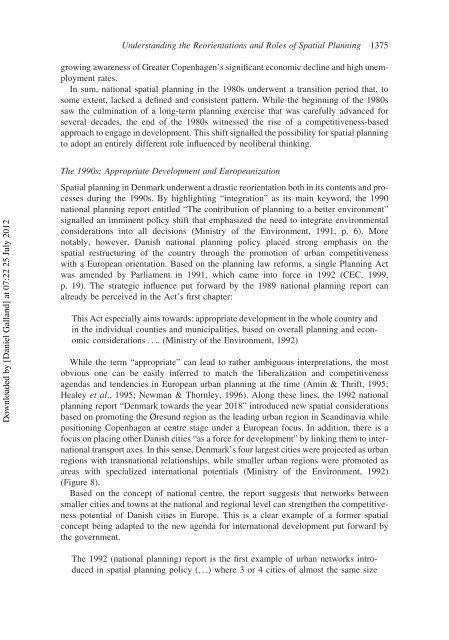Galland EPS 2012 - VBN
Galland EPS 2012 - VBN
Galland EPS 2012 - VBN
You also want an ePaper? Increase the reach of your titles
YUMPU automatically turns print PDFs into web optimized ePapers that Google loves.
Understanding the Reorientations and Roles of Spatial Planning 1375<br />
growing awareness of Greater Copenhagen’s significant economic decline and high unemployment<br />
rates.<br />
In sum, national spatial planning in the 1980s underwent a transition period that, to<br />
some extent, lacked a defined and consistent pattern. While the beginning of the 1980s<br />
saw the culmination of a long-term planning exercise that was carefully advanced for<br />
several decades, the end of the 1980s witnessed the rise of a competitiveness-based<br />
approach to engage in development. This shift signalled the possibility for spatial planning<br />
to adopt an entirely different role influenced by neoliberal thinking.<br />
Downloaded by [Daniel <strong>Galland</strong>] at 07:22 25 July <strong>2012</strong><br />
The 1990s: Appropriate Development and Europeanization<br />
Spatial planning in Denmark underwent a drastic reorientation both in its contents and processes<br />
during the 1990s. By highlighting “integration” as its main keyword, the 1990<br />
national planning report entitled “The contribution of planning to a better environment”<br />
signalled an imminent policy shift that emphasized the need to integrate environmental<br />
considerations into all decisions (Ministry of the Environment, 1991, p. 6). More<br />
notably, however, Danish national planning policy placed strong emphasis on the<br />
spatial restructuring of the country through the promotion of urban competitiveness<br />
with a European orientation. Based on the planning law reforms, a single Planning Act<br />
was amended by Parliament in 1991, which came into force in 1992 (CEC, 1999,<br />
p. 19). The strategic influence put forward by the 1989 national planning report can<br />
already be perceived in the Act’s first chapter:<br />
This Act especially aims towards: appropriate development in the whole country and<br />
in the individual counties and municipalities, based on overall planning and economic<br />
considerations .... (Ministry of the Environment, 1992)<br />
While the term “appropriate” can lead to rather ambiguous interpretations, the most<br />
obvious one can be easily inferred to match the liberalization and competitiveness<br />
agendas and tendencies in European urban planning at the time (Amin & Thrift, 1995;<br />
Healey et al., 1995; Newman & Thornley, 1996). Along these lines, the 1992 national<br />
planning report “Denmark towards the year 2018” introduced new spatial considerations<br />
based on promoting the Øresund region as the leading urban region in Scandinavia while<br />
positioning Copenhagen at centre stage under a European focus. In addition, there is a<br />
focus on placing other Danish cities “as a force for development” by linking them to international<br />
transport axes. In this sense, Denmark’s four largest cities were projected as urban<br />
regions with transnational relationships, while smaller urban regions were promoted as<br />
areas with specialized international potentials (Ministry of the Environment, 1992)<br />
(Figure 8).<br />
Based on the concept of national centre, the report suggests that networks between<br />
smaller cities and towns at the national and regional level can strengthen the competitiveness<br />
potential of Danish cities in Europe. This is a clear example of a former spatial<br />
concept being adapted to the new agenda for international development put forward by<br />
the government.<br />
The 1992 (national planning) report is the first example of urban networks introduced<br />
in spatial planning policy (...) where 3 or 4 cities of almost the same size
















